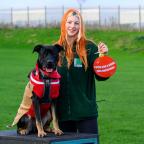
8 Expert Ways to Help Dog Owners Make Their Hay Fever Scamper this Spring
Tree pollen is one of the two main types of pollen which affect hay fever sufferers in the UK. Tree pollen starts in February or March and peaks in April or May. Airborne allergens expert Max Wiseberg explains the body’s reaction to the pollen and gives his 8 top tips to help dog owners reduce the effects of tree pollen on their hay fever.
“The most common hay fever symptoms,” explains Max, “include sneezing, a runny nose, a stuffed up nose, itchy and watery or streaming eyes, nasal congestion and a general stuffed up feeling in the nose and throat. Some people also experience itching around the face and mouth including an itchy mouth, itchy roof of mouth, and a burning sensation in the throat. Headaches and wheezing can also occur.”
“Hay fever is the result of our immune system’s overreaction to innocuous substances such as pollen. The body produces histamines. Normal amounts of histamines in your brain are good – they are the things that keep us alert, attentive and awake. But, when there are too many in the body, they produce the sneezing and other symptoms common to hay fever sufferers.”
There are many ways to help reduce or prevent the symptoms of hay fever – Max’s Top 8 Tips are:
- “Stop pollen from getting in your eyes and hair when you’re out walking your dog. Wear a hat or other head covering so that tree pollen does not get blown into your hair. And wraparound sunglasses will help stop pollen getting into your eyes.”
- “Apply an organic, drug-free allergen barrier balm such as HayMax, around the rim of the nostrils and bones of the eyes before you go out walking your dog. This will stop some of the pollen getting in your body. Everyone can tolerate a certain amount of pollen without reaction – known as their ‘trigger level’. Once this level is reached, an allergic reaction will start to occur. HayMax organic drug-free allergen barrier balms have been proven to trap over 1/3 of pollen grains before they enter the body [1].”
- “Don’t bring pollen back home with you. Remove your footwear at the door to avoid bringing pollen into your home. Changing your clothes and showering when you get home will remove any pollen from your hair and clothes. Wash and groom your dog regularly to remove any pollen from their fur.”
- “Make sure you get a good night’s sleep. Hay fever can affect your sleep. Shower at night before sleeping to remove pollen particles from your hair and body. Then apply an allergen barrier balm to block the pollen. Change and wash your bedding regularly to remove allergens. And keep your dog out of the room in which you sleep.”
- “Try an antihistamine. Tablets and capsules can relieve most symptoms – sneezing, itchy, runny eyes, skin irritation, itchy nose and throat – but are less effective for nasal congestion. Antihistamine nasal sprays can quickly ease itching, sneezing and watering but are generally only proof against mild symptoms.”
- “Create your own Hay Fever First Aid Kit if your symptoms are particularly bad, or pollen counts are really high. I recommend one or more natural products, including an allergen barrier balm, one (and only one) antihistamine, one (and only one) steroid nasal spray and eye drops.”
- “Understand which types of pollen you are allergic to, to help you to plan your allergy management better. If you know that you are allergic to beech or oak pollen for example, you can try to avoid walking your dog in areas where these types of trees grow, or at least prepare if you know you are going to be near those trees.”
- “Check out my website haymax.biz/hay-fever/ for more ideas on how you can help reduce the effects of tree pollen. There is currently no cure for hay fever, but there are many things you can do or take to help. Good luck.”







